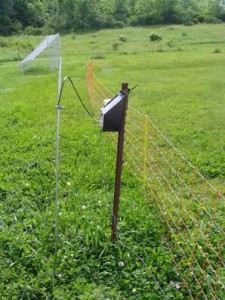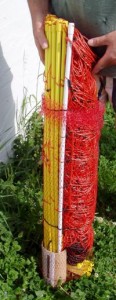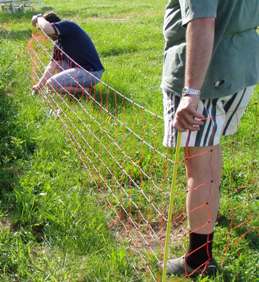 And, I’m back. Sort of. The orthopedist’s visit last week was a success and I’m assigned to start physical therapy tomorrow. I have to admit that I’m not really looking forward to this. It’s going to hurt and there is no way to step around that fact but it’s the only way I’m going to get even close to the mobility I had with the arm before I had the accident and broke my shoulder.
And, I’m back. Sort of. The orthopedist’s visit last week was a success and I’m assigned to start physical therapy tomorrow. I have to admit that I’m not really looking forward to this. It’s going to hurt and there is no way to step around that fact but it’s the only way I’m going to get even close to the mobility I had with the arm before I had the accident and broke my shoulder.
It’s been a little bit tough to put together content here because so much of what I do requires two hands but I’ve got something today because the two hands (well, technically the four hands since it is The Boy and the DH who did it; I just stood there and documented it) were provided by others.
This year, we’ve expanded our livestock raising again. In addition to the chickens, we’ve got turkey poults and we have three lambs out in the pasture (we’re supposed to be getting another one, but I’ll believe it when the little bugger shows up). Now, we are not new to raising sheep. Until 2002, we had between 10 and 15 breeding ewes and raised lambs for the Easter market. Why we got out of that is a story for another time but this is a little bit different: the lambs were bought young from another breeder and we are only keeping them through the fall, when they will, as we say coyly around here, “go down the road”. They are also being raised strictly on pasture, so we are avoiding the costs (both literal, environmental and healthwise) from feeding them commercial feeds.
Now, I have to admit that one of our issues here at Chez Siberia in the past for livestock is that our pastures were not really tiptop. Part of that has to do with the quality of the topsoil (thin, rocky, lots of clay), the lay of the land itself (sloping and wet in spots), and the fact that we really did not know what we were doing. We used permanent fencing set up into paddocks and probably should have rotated them through more often. But we didn’t. So the sheep (as is their wont) nibbled the grass right down to the rocks and by August, we’d have to start feeding hay (they’ll do that; that is why they say that a sheep’s life is really only limited to how long they keep their teeth). But we’ve been reseeding and judiciously mowing and things look pretty good. If we get some decent rain across the summer, the pastures might hold out through the fall. If not, we’ll just have to go down our road to buy hay.
The other change is that we have gone with ‘electro-netting’, a type of movable fencing that gives real flexibility in terms of setting up a paddock area for the sheep, and moving them to new grass as you need it. That’s the photo at the top. We bought two sets so that we could set up a new area while the sheep are in their current area and then just open one side to get them on the new grass. Here is how it works:
The fencing comes in a roll with the fence posts installed right in it.  The fence runs off a solar charger, which is attached to a ground rod (you’ll have to get both of those at your local farm supply place) and to the fence with wires. Solar chargers come with on/off switches so that you can get things set up and just turn it on. You will also want to get the charger before you put up the fence because it will take several days of sunshine to get the unit all charged up to run the fence. In the photo, you see that all the fence posts are yellow except for one. The white fence post is the one at the very end of the roll and you grab that one first and stick that into the ground at the start of the new run (you’ll want to do this basically right next to the area you are currently using for livestock and then you unroll the rest of the fencing.
The fence runs off a solar charger, which is attached to a ground rod (you’ll have to get both of those at your local farm supply place) and to the fence with wires. Solar chargers come with on/off switches so that you can get things set up and just turn it on. You will also want to get the charger before you put up the fence because it will take several days of sunshine to get the unit all charged up to run the fence. In the photo, you see that all the fence posts are yellow except for one. The white fence post is the one at the very end of the roll and you grab that one first and stick that into the ground at the start of the new run (you’ll want to do this basically right next to the area you are currently using for livestock and then you unroll the rest of the fencing.
 You literally just stick the fence posts (which have a metal core by the way) into the ground as you go, leaving a little bit of slack.
You literally just stick the fence posts (which have a metal core by the way) into the ground as you go, leaving a little bit of slack.
 At the corners, you will use a cord and a spike to put some strain on the fencing (like with putting up a tent) and that will straighten out the fence and make it tight.
At the corners, you will use a cord and a spike to put some strain on the fencing (like with putting up a tent) and that will straighten out the fence and make it tight.
 Then, you turn off the fence at the solar charger, roll a bit back to create an opening, walk behind the animals and they will naturally move in front of you and go to the new grass. Genius.
Then, you turn off the fence at the solar charger, roll a bit back to create an opening, walk behind the animals and they will naturally move in front of you and go to the new grass. Genius.
Electro-web fencing can be found in several different conformations in terms of the holes in the web. There are set ups for poultry (with little holes in the lower part and larger holes toward the top), for gardens to keep out rabbits, and for larger livestock also.
How safe is electro-web fencing? Well, like all electric fencing, the deterrent effect (either from inside or outside) is all based on the size of the kick from the charger. The fences are all rated and labeled in terms of their electric power. All electric fences should be regarded with a great deal of care and respect; I certainly would not allow kids to be around it without an knowledgeable adult present.
